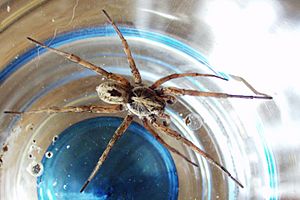Tigrosa helluo facts for kids
Quick facts for kids Tigrosa helluo |
|
|---|---|
 |
|
| Tigrosa helluo, female | |
| Scientific classification | |
| Kingdom: | |
| Phylum: | |
| Class: | |
| Order: | |
| Suborder: | |
| Family: | |
| Subfamily: |
Lycosinae
|
| Genus: | |
| Species: |
T. helluo
|
The Tigrosa helluo is a large type of wolf spider found in America. These spiders are known for their interesting ways of caring for their young. They are part of a group of spiders called Tigrosa.
This spider used to be known by other names. For a while, it was called Hogna helluo. Even before that, it was known as Lycosa helluo. Scientists sometimes change how they classify animals as they learn more about them.
About the Tigrosa Helluo Spider
Tigrosa helluo spiders can be quite big. Female spiders are usually larger than males. A female can grow to have a body length of up to 21 millimeters (that's about the size of a large button!). Males are smaller, reaching about 12 millimeters.
Where They Live
Female Tigrosa helluo spiders often make their homes in shallow holes. They usually find these spots under rocks. They dig a small hole and then line it with silk. This silk makes their home a bit more comfortable and secure.
Reproduction and Life Cycle
When a female Tigrosa helluo spider is ready to lay eggs, she creates a special silk sac. She puts all her eggs inside this sac. What's really cool is that she doesn't just leave the egg sac somewhere. Instead, she carries it with her! She attaches the egg sac to her spinnerets, which are the parts of her body that produce silk. This way, she can keep her precious eggs safe wherever she goes.
A single female spider can lay a lot of eggs at once. She might lay anywhere from 150 to 500 eggs in one go!
After the baby spiders hatch from their eggs, they don't just run off on their own. All mother wolf spiders, including Tigrosa helluo, let their babies climb onto their backs. The tiny spiderlings ride on their mother's abdomen for several days. This gives them a safe place to stay until they are big enough to explore the world on their own.

